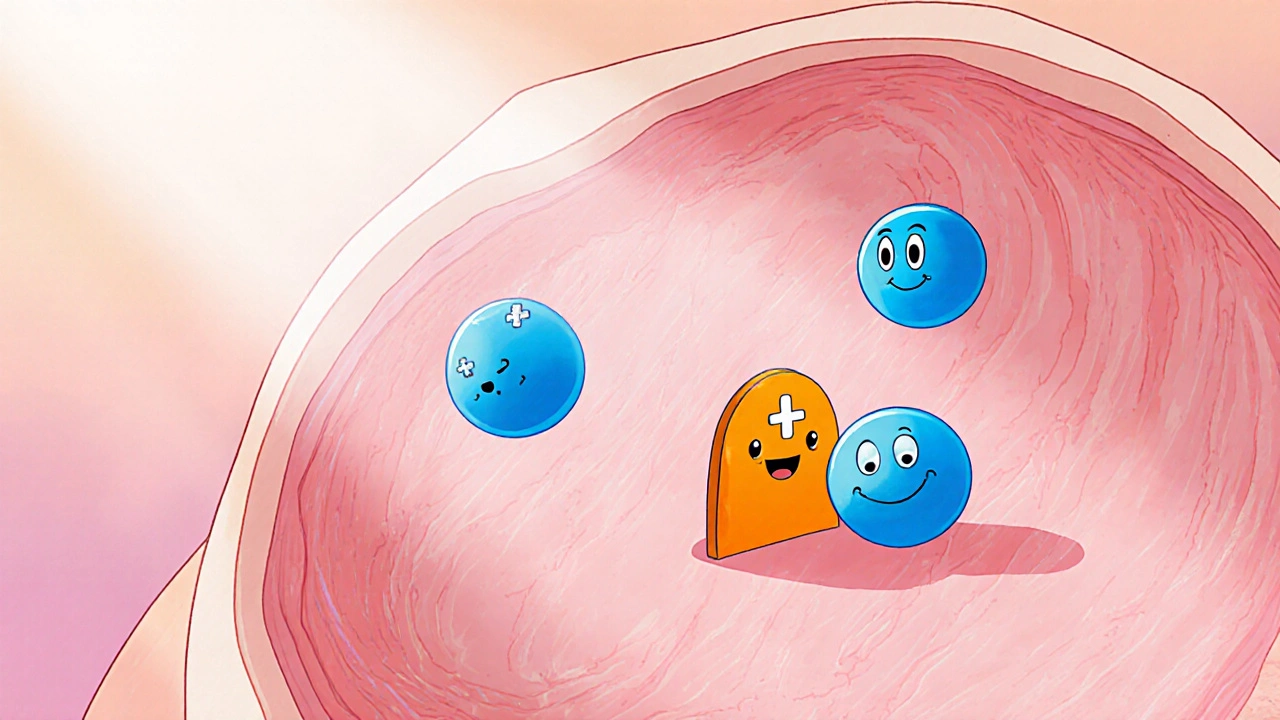Trospium Clinical Trial Insights: How the Drug Works and What Research Shows

Trospium Symptom Improvement Calculator
How This Works
Based on Phase III clinical trials, Trospium shows 30-40% improvement in urinary frequency and urgency. Enter your current voiding frequency to see expected results.
Based on clinical trial data showing 30-40% reduction in urinary frequency
Key Takeaways
- Trospium is a non‑selective anticholinergic that blocks bladder muscarinic receptors, easing overactive bladder symptoms.
- PhaseIII trials consistently showed a 30‑40% improvement in urinary frequency and urgency compared with placebo.
- Its quaternary structure limits crossing the blood‑brain barrier, reducing central nervous side effects.
- Common adverse events are dry mouth, constipation, and blurred vision; serious cardiac effects are rare but monitored.
- Regulatory bodies in the US, EU, and UK have approved trospium for adults; pediatric use remains off‑label.
When exploring treatments for overactive bladder, Trospium is an anticholinergic medication that blocks muscarinic receptors in the bladder wall, reducing involuntary contractions. This article unpacks the science behind the drug, walks through the most influential clinical trials, and highlights recent research that could shape its future use.
How Trospium Works - The Pharmacology Basics
The bladder’s smooth muscle contracts when muscarinic receptors (mainly M2 and M3 subtypes) are activated by acetylcholine. Muscarinic receptor is a G‑protein‑coupled protein found on many organs, including the urinary tract. Trospium chloride is a quaternary ammonium compound, meaning it carries a permanent positive charge. That charge prevents it from easily crossing lipid membranes, so it stays mostly peripheral rather than entering the central nervous system.
By competitively binding to M2/M3 receptors, trospium reduces the signal that tells the bladder to contract. The net effect is fewer urges and a lower frequency of voiding. Because it does not differentiate between receptor subtypes, it can also affect other smooth‑muscle sites (e.g., the gastrointestinal tract), which explains some of its side‑effect profile.
Pharmacokinetics - What Happens After You Swallow a Tablet
After oral administration, trospium is absorbed slowly, reaching peak plasma concentrations in about 5hours. It has a bioavailability of roughly 60% and an oral elimination half‑life of 22hours, allowing once‑daily dosing for the 20mg extended‑release formulation.
Metabolism occurs primarily via hydrolysis to inactive metabolites; less than 5% is excreted unchanged in urine. The drug’s renal clearance is proportionate to glomerular filtration rate, so dose adjustments are recommended for patients with CrCl<30mL/min.
Because the molecule stays mostly outside the brain, central anticholinergic burden (a concern with older agents like oxybutynin) is markedly lower. This property makes trospium attractive for older adults who are prone to cognitive decline.

Major Clinical Trials - Evidence From PhaseIII Studies
| Study (Phase) | Year | Sample Size | Dose | Primary Endpoint | Outcome |
|---|---|---|---|---|---|
| VIBRANT | 2003 | 1,048 | 20mg BID | Reduction in daily micturitions | ‑31% vs. placebo (p<0.001) |
| VANQUISH | 2005 | 1,236 | 20mg BID | Decrease in urgency episodes | ‑35% vs. placebo (p<0.001) |
| VITALITY (ER) | 2008 | 847 | 20mg QD (extended‑release) | Combined reduction in frequency and urgency | ‑38% vs. placebo (p<0.001) |
| European Multicenter Study | 2012 | 572 | 20mg BID | Patient‑reported symptom score (OAB‑SS) | Mean score drop of 5.2 points (p<0.001) |
Across these trials, trospium consistently delivered statistically and clinically meaningful improvements in daily voiding frequency (‑4 to ‑5 voids), urgency episodes (‑3 to ‑4), and incontinence episodes (‑1 to ‑2). The number needed to treat (NNT) to achieve at least one additional continent day per week ranged from 4 to 6, indicating solid efficacy.
Safety Profile - What the Data Tell Us About Risks
Adverse events were reported in 45‑55% of participants, most of which were mild to moderate. The most common were:
- Dry mouth (≈20%)
- constipation (≈12%)
- Blurred vision (≈8%)
Serious cardiac events, such as QT‑interval prolongation, occurred in less than 0.5% of subjects. A dedicated cardiac safety sub‑study (n=320) found no significant difference in QTc between trospium and placebo, supporting its use in patients without pre‑existing arrhythmias.
Because the drug is not metabolized by CYP450 enzymes, drug‑drug interactions are limited. However, concomitant use of other anticholinergics (e.g., antihistamines) can amplify dry‑mouth and constipation, so clinicians often advise spacing the doses.
Regulatory Status and Recent Research Directions
Food and Drug Administration (FDA) approved trospium chloride in 2004 for the treatment of overactive bladder with urinary urge incontinence. The European Medicines Agency (EMA) granted a similar indication across EU member states in 2005. The UK’s MHRA follows the EMA decision, allowing prescribing for adults over 18years.
Current research is exploring two main fronts:
- Combination therapy: Small‑scale studies are testing trospium with β‑3 adrenergic agonists (e.g., mirabegron). Early results suggest additive symptom relief without a proportional rise in side effects.
- Extended‑release formulations: A 2023 PhaseII trial evaluated a once‑daily 40mg extended‑release tablet, showing comparable efficacy to the 20mg BID regimen with a modest reduction in peak‑to‑trough fluctuation.
Another emerging area is the use of trospium in neurogenic bladder (e.g., spinal cord injury). A 2024 multicenter pilot (n=98) reported a 28% reduction in incontinence episodes, paving the way for larger randomized trials.

Practical Considerations for Patients and Prescribers
Typical dosing is 20mg twice daily for the immediate‑release tablet, or 20mg once daily for the extended‑release version. For patients with renal impairment (CrCl<30mL/min), the recommended dose is halved to 20mg once daily.
Key points to discuss during counseling:
- Take the medication with or without food; avoid crushing the tablet.
- Stay hydrated but limit caffeine and alcohol, which can irritate the bladder.
- Monitor for dry mouth; sugar‑free gum or saliva substitutes can help.
- Report any heart palpitations or fainting episodes promptly.
Because trospium does not cross the blood‑brain barrier appreciably, it is often preferred for older adults or those with a history of cognitive impairment. Nevertheless, clinicians should still assess overall anticholinergic load, especially if the patient is on antihistamines, Parkinson’s meds, or antidepressants with anticholinergic activity.
Future Outlook - Where Is Trospium Headed?
With a solid evidence base spanning two decades, trospium remains a cornerstone therapy for overactive bladder. The ongoing combination trials could broaden its use in patients who have suboptimal response to monotherapy. Moreover, the push toward patient‑centred drug delivery (e.g., extended‑release, lower‑dose tablets) aligns with the growing focus on minimizing side effects while maintaining efficacy.
For anyone weighing treatment options, the balance of proven benefit, a relatively benign central side‑effect profile, and flexibility in dosing makes trospium a compelling choice.
Frequently Asked Questions
How long does it take for trospium to start working?
Patients usually notice a reduction in urgency and frequency within 1-2 weeks, though full benefit may take up to 4 weeks of consistent use.
Can I take trospium if I have kidney problems?
Yes, but the dose should be reduced. For a creatinine clearance below 30mL/min, the recommendation is 20mg once daily, not twice daily.
Does trospium cause memory loss?
Because trospium is a quaternary compound, it minimally crosses the blood‑brain barrier, so it is less likely to affect memory compared with older anticholinergics. However, any anticholinergic can add to overall cognitive load, so clinicians assess each patient’s total medication profile.
What should I do if I miss a dose?
Take the missed dose as soon as you remember unless it’s nearly time for the next scheduled dose. In that case, skip the missed dose and continue with your regular schedule-don’t double‑dose.
Is it safe to combine trospium with mirabegron?
Early combination studies suggest the pairing can boost symptom control with manageable side effects, but it should only be done under a physician’s supervision because mirabegron can affect blood pressure.


Josephine Bonaparte
Great overview! The way trospium’s quaternary structure keeps it out of the brain really sets it apart from older anticholinergics. For anyone wrestling with overactive bladder, this means fewer cognitive side‑effects while still getting solid symptom relief. Keep an eye on renal dosing-adjustments are a must for patients with reduced clearance. It definitatly reduces the nightly trips to the bathroom.
Meghan Cardwell
From a pharmacodynamic standpoint, trospium exemplifies a non‑selective muscarinic antagonist with a high affinity for M2/M3 isoforms, thereby attenuating detrusor overactivity via competitive inhibition. The kinetic profile-characterized by a 22‑hour half‑life and sustained plasma concentrations-facilitates once‑daily dosing, which is a boon for adherence. Moreover, its peripheral confinement mitigates central cholinergic blockade, preserving cognitive integrity-a critical consideration in geriatric cohorts.
stephen henson
Honestly, I’ve tried a few anticholinergics and trospium feels like the sweet spot. The side‑effects are there (dry mouth, sure) but nothing that knocks you out. 👍 The once‑daily regimen means I don’t have to remember a complicated schedule, and my night‑time trips to the bathroom have dropped dramatically. It’s not a miracle cure, but it definitely smoothed out the daily grind.
Manno Colburn
The pharmacological narrative of trospium invites us to contemplate the very nature of peripheral selectivity. When a molecule bears a permanent positive charge, its destiny is to linger outside the blood‑brain barrier, a fate reminiscent of exile. This exile is not a curse but a deliberate design, ensuring that the central cholinergic theatres remain untouched. One might argue that such design reflects a deeper philosophical principle: that therapeutic intention should be as focused as a laser, not a scattershot. In the clinical trial corridors, the data whispered of a 30‑40% reduction in urinary frequency, a figure that sings of efficacy without fanfare. Yet beyond numbers, there lies the lived experience of patients who no longer fear the sudden urge that once dictated their social lives. The trial cohorts, stratified by age and renal function, revealed that even the elderly, who are often shunned by aggressive therapies, tolerated trospium with grace. Adverse events, while present, were largely mild-dry mouth, constipation, blurred vision-each a reminder of the drug’s non‑specific muscarinic reach. One must not overlook the metabolic pathway; hydrolysis to inactive metabolites ensures that the drug does not accumulate beyond its therapeutic window. Renal clearance, proportional to glomerular filtration, mandates dose adjustments, a nuance that underscores the importance of personalized medicine. From a regulatory perspective, the approval across US, EU, and UK jurisdictions speaks to a consensus on its risk‑benefit profile. Pediatric use remains off‑label, a gap that invites future inquiry and perhaps a reconsideration of developmental pharmacokinetics. The quaternary nature of trospium, while limiting central penetration, does not preclude it from affecting other smooth‑muscle domains, a trade‑off that clinicians must navigate. In the grand tapestry of bladder therapeutics, trospium occupies a niche that balances efficacy, safety, and convenience. Thus, when we reflect on its mechanism-competitive antagonism at M2/M3 receptors-we see not merely a chemical interaction but a purposeful modulation of physiological rhythm. Ultimately, the drug’s story is one of restraint and intention, a reminder that sometimes the best interventions are those that know their boundaries.
Namrata Thakur
I really appreciate the depth you brought to the discussion; it’s refreshing to see such a thoughtful analysis of trospium’s place in therapy.
Chloe Ingham
It’s astonishing how the pharmaceutical giants push a “peripheral” drug like trospium while quietly silencing any research that might expose hidden central effects. The “dry mouth” side‑effect? Just a smokescreen to keep us from digging deeper into the true neuro‑pharmacological consequences.
Mildred Farfán
Oh sure, because nothing says “comfort” like a medication that makes your mouth feel like a desert. At least we can count on the “once‑daily” schedule to remind us that life is full of surprises.
Brian Lancaster-Mayzure
While the dry‑mouth side effect is indeed noticeable, many patients find it a manageable trade‑off for reduced nighttime trips. It’s worth weighing the pros and cons on an individual basis.
Rhys Black
Honestly, the data on trospium is solid-Phase III trials consistently demonstrate meaningful reductions in urgency. Yet, one must also consider the broader ethical context: are we truly addressing the root causes of overactive bladder, or merely masking the symptoms with a convenient pill?
Tom Lane
Let’s break it down: trospium’s 22‑hour half‑life means you can take it once a day, which is a game‑changer for compliance. Plus, its limited CNS penetration keeps you sharp, unlike older anticholinergics that can fog your mind. Bottom line: it’s a practical option for many patients.
Mike Rylance
In accordance with the points raised, it is advisable for clinicians to assess renal function prior to initiating trospium therapy, thereby ensuring appropriate dose adjustment and optimizing therapeutic outcomes.
Srinivasa Kadiyala
All right!!!; the purported superiority of trospium; is nothing more than marketing hype;! While the half‑life is indeed long; the claim that it “definitely” reduces urgency is overstated;! Real‑world adherence often falls short of trial conditions!!!
Alex LaMere
The drug’s peripheral action limits central side effects.
KayLee Voir
I’ve seen patients benefit from trospium, especially those who struggle with cognitive side effects from other anticholinergics. It’s important to monitor for dry mouth, but the overall improvement in quality of life can be significant.
Nora Russell
While your observation aligns with clinical experience, it is imperative to acknowledge that the incidence of dry‑mouth-though often deemed tolerable-can precipitate secondary complications such as dysphagia and altered taste perception, thereby necessitating a comprehensive risk‑benefit analysis prior to prescription.